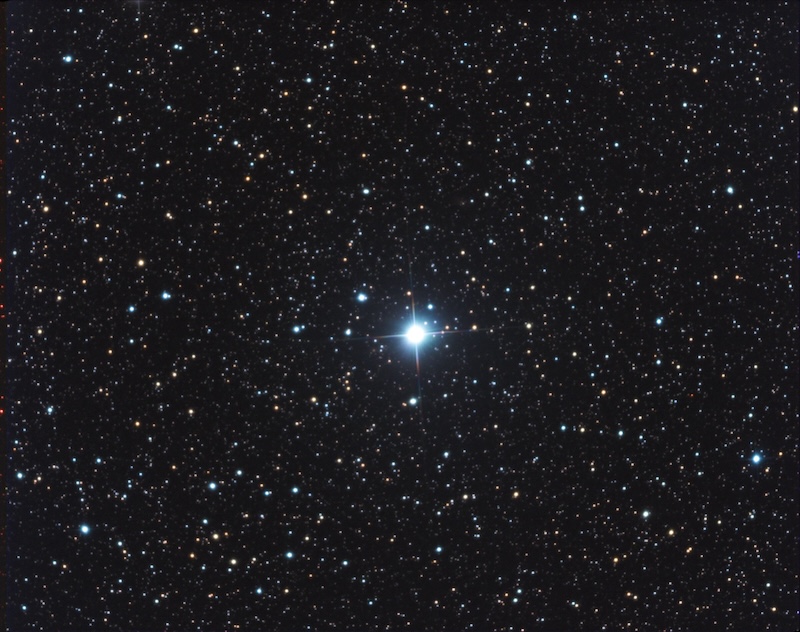 View at EarthSky Community Photos. | Eliot Herman captured this image from Chile on June 27, 2025, and wrote: “Another bright nova in June 2025. That’s 2, after a long drought. This one (Nova Vela 0572) is very far south so I imaged it with a remote telescope. This was captured about a day-and-a-half after its discovery. And it’s now blue. It’ll be interesting to follow as it reddens in the coming weeks.” Thank you, Eliot!
View at EarthSky Community Photos. | Eliot Herman captured this image from Chile on June 27, 2025, and wrote: “Another bright nova in June 2025. That’s 2, after a long drought. This one (Nova Vela 0572) is very far south so I imaged it with a remote telescope. This was captured about a day-and-a-half after its discovery. And it’s now blue. It’ll be interesting to follow as it reddens in the coming weeks.” Thank you, Eliot!
And now there are 2 novas visible in the sky!
Earlier this month, we reported a ‘new star’ – or nova – visible to the eye in the constellation Lupus. But, in what’s likely a once-in-a-lifetime event, southern observers can now witness two novas simultaneously visible to the unaided eye.
The 2nd ‘new star’ or nova in the constellation Vela is called V572 Velorum,. It’s visible to the unaided eye from Earth’s Southern Hemisphere (the earlier nova, V462 Lupi, is visible from most of Earth).
John Seach and Andrew Pearce discovered the 2nd nova on June 25. At discovery, it was shining at magnitude +5.7! That’s faint, but it’s within the limit for viewing with the unaided eye. Recent observations indicate it is currently shining even more brightly than at its discovery, at a magnitude of +5.5.
Previously, V462 Lupi had burst into view on June 12. That first nova is currently shining around +5.9 magnitude, barely within the limit for viewing with the unaided eye. Still, from a dark sky location, it might be possible to glimpse both V462 Lupi and V572 Velorum from Earth’s Southern Hemisphere. It’s a rare treat to witness a single nova. But the occurrence of two novae simultaneously is super rare!
Finder chart for the nova
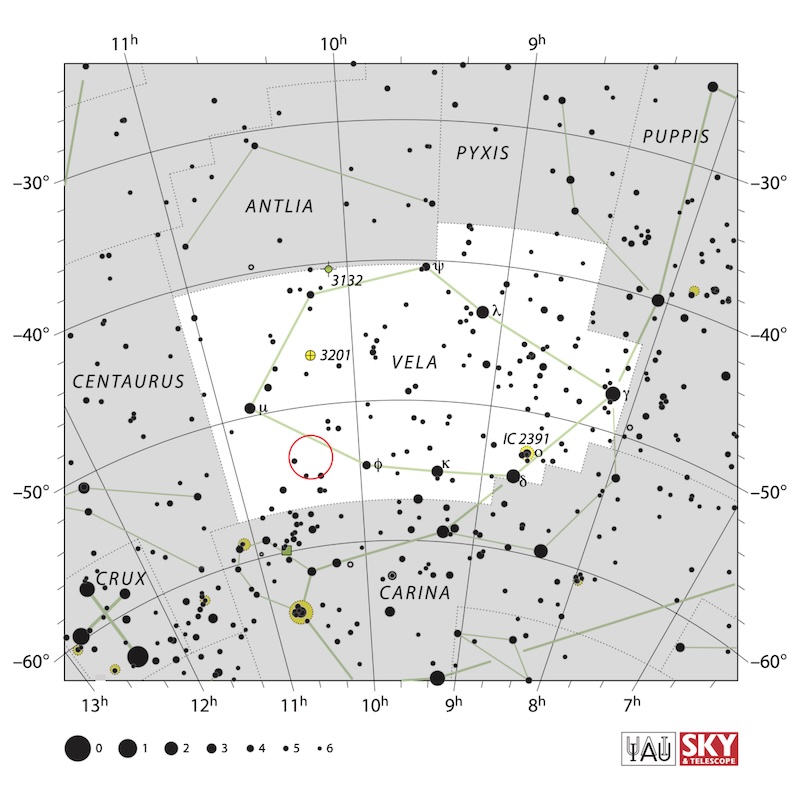 The location of nova V572 Velorum is location marked in constellation Vela. Image via Wikipedia. CC BY 4.0.
The location of nova V572 Velorum is location marked in constellation Vela. Image via Wikipedia. CC BY 4.0.
Seeing 2 novae at once?
Astronomer Stephen James O’Meara, who lives in Africa and who has observed both novas, told EarthSky:
I am still looking at databases, (to see if this happened before) but the first instance I have found occurred ~17 years ago in 2018. AAVSO light curves show that FM Circini (Nova Circinis 2018) reached a peak brightness of magnitude 5.8 on March 22, 2018, and on that same day, Nova V906 Carinae peaked at around magnitude 5.9. So the two novae shared a similar naked-eye magnitude albeit briefly. Once again, these were Southern Hemisphere novae. So these are rare events.
Images of the novae
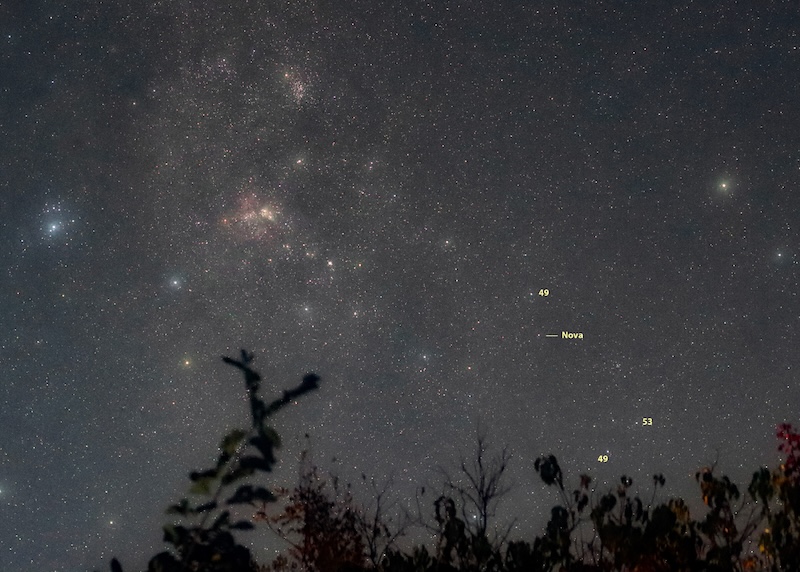 Here’s an image showing Nova Velorum on June 28, 2025. The nova is identified and stars of comparable magnitudes are noted as well. Image via Stephen O’Meara. Used with permission.
Here’s an image showing Nova Velorum on June 28, 2025. The nova is identified and stars of comparable magnitudes are noted as well. Image via Stephen O’Meara. Used with permission.
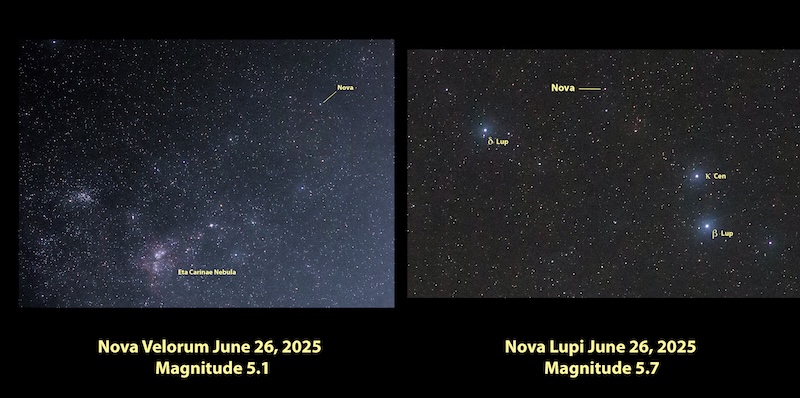 Here’s a composite image showing both novae on the same night, June 26, 2025. Image via Stephen O’Meara. Used with permission.
Here’s a composite image showing both novae on the same night, June 26, 2025. Image via Stephen O’Meara. Used with permission.
Did you catch a picture of the nova? Submit it here.
How a nova occurs
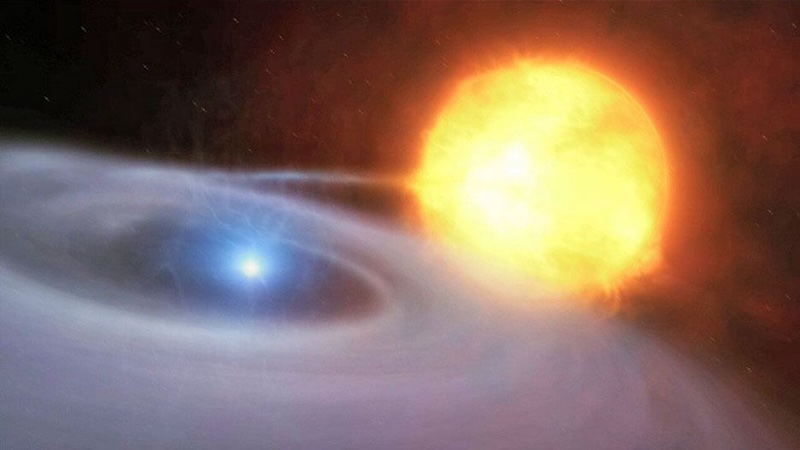 A nova always involves 2 closely-orbiting stars. One is a tiny, dense white dwarf about the size of the Earth. And the companion star may be similar in mass to our sun. The white dwarf’s powerful gravity siphons material (mostly hydrogen) away from its companion, over a timespan of thousands of years. The hot gas forms a disk around the dwarf, which funnels the material down to the star’s surface. In time, the pilfered gas is compacted and heated until it ignites in a massive thermonuclear blast a million times brighter than the light of both stars combined. To our eyes the explosion looks like a brand new star in the night sky. Previously, the pair was there for a long, long time, but too faint to call attention to itself. Good news. The dwarf typically survives the blast and begins anew to gather more hydrogen for the next eruption. When you know what’s behind that single pinpoint of light, it’s a marvel! Chart via Astro Bob. Used with permission.
A nova always involves 2 closely-orbiting stars. One is a tiny, dense white dwarf about the size of the Earth. And the companion star may be similar in mass to our sun. The white dwarf’s powerful gravity siphons material (mostly hydrogen) away from its companion, over a timespan of thousands of years. The hot gas forms a disk around the dwarf, which funnels the material down to the star’s surface. In time, the pilfered gas is compacted and heated until it ignites in a massive thermonuclear blast a million times brighter than the light of both stars combined. To our eyes the explosion looks like a brand new star in the night sky. Previously, the pair was there for a long, long time, but too faint to call attention to itself. Good news. The dwarf typically survives the blast and begins anew to gather more hydrogen for the next eruption. When you know what’s behind that single pinpoint of light, it’s a marvel! Chart via Astro Bob. Used with permission.
Bottom line: A ‘new star’, or a nova, was discovered in Vela on June 25, 2025. It’s bright enough to see with the eye! So you can see two novae at once if you are in the Southern Hemisphere.
Marcy Curran
View Articles
About the Author:
Meet Marcy Curran, our voice of the night sky on EarthSky YouTube. Check out her popular short videos in the Sky category on our YouTube channel. When she’s not making videos, Marcy is an EarthSky editor, helping to keep our night sky guide up-to-date and just generally helping to keep the wheels turning around here. Marcy has enjoyed stargazing since she was a child, going on family camping trips under the dark skies of Wyoming. She bought her first telescope in time to see Halley’s Comet when it visited the inner solar system in 1986. She co-founded her local astronomy club and remains an active board member. Marcy taught astronomy at her local community college for over 20 years. She and her husband live in Wyoming, in a rural location, with an all-sky camera and super-good horizon views! And, their observatory will soon be ready to photograph the night sky.